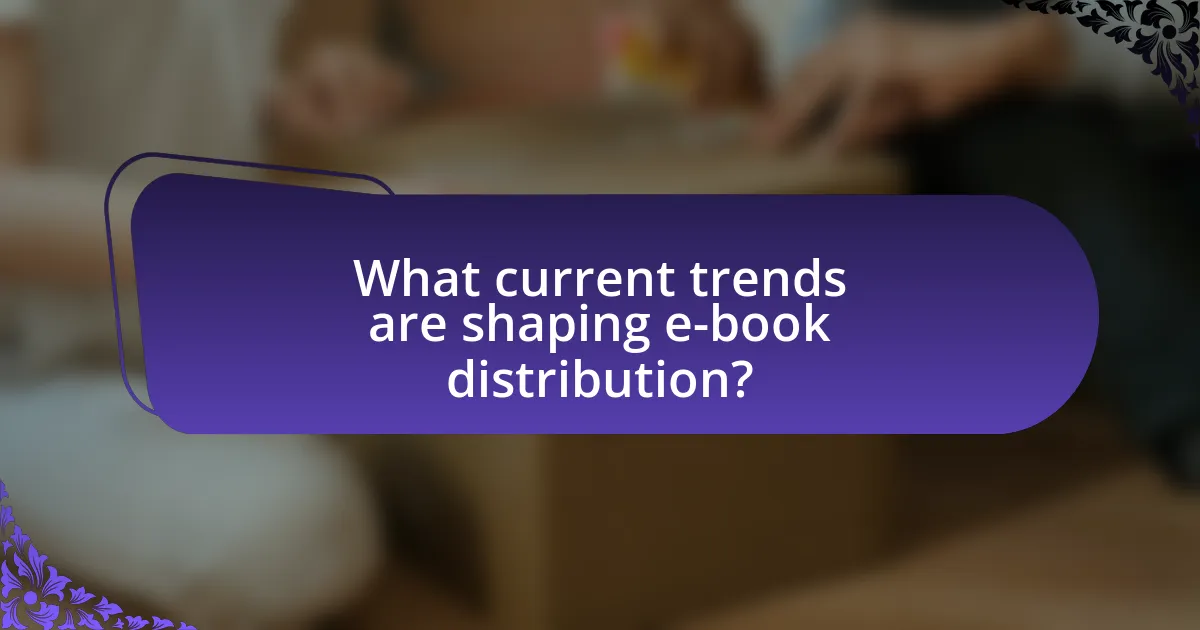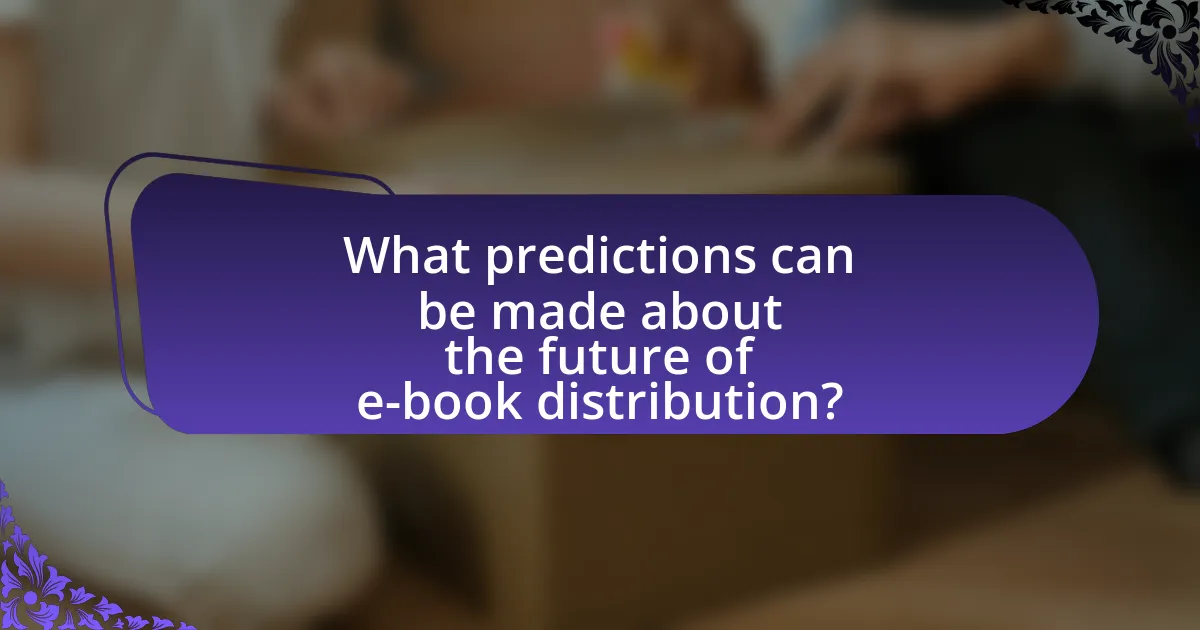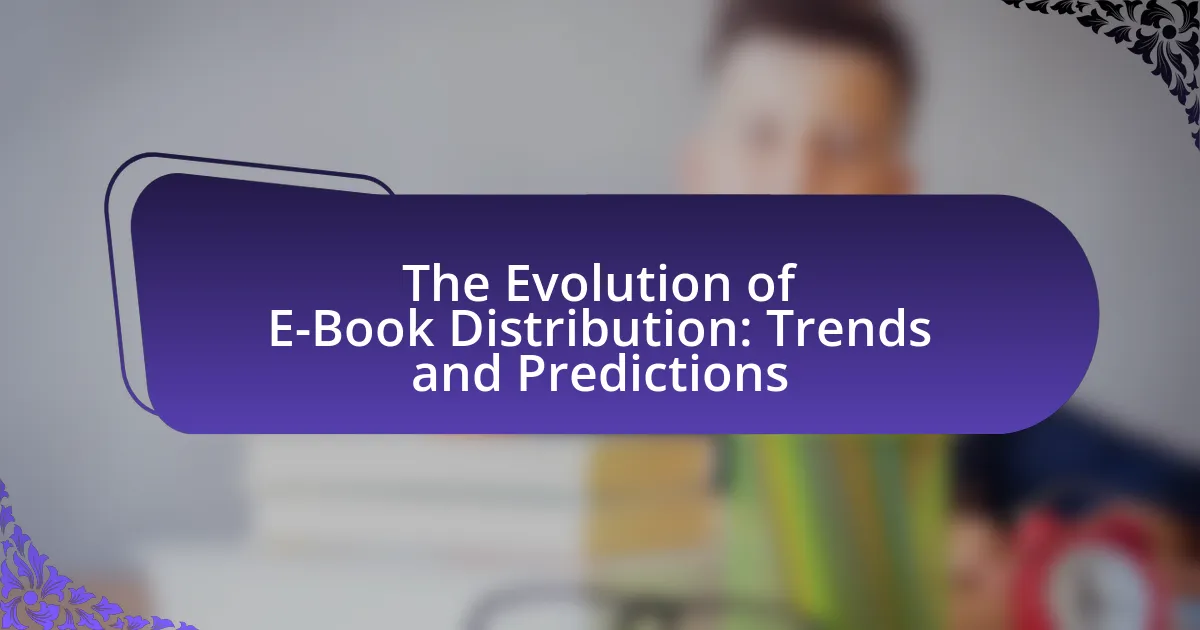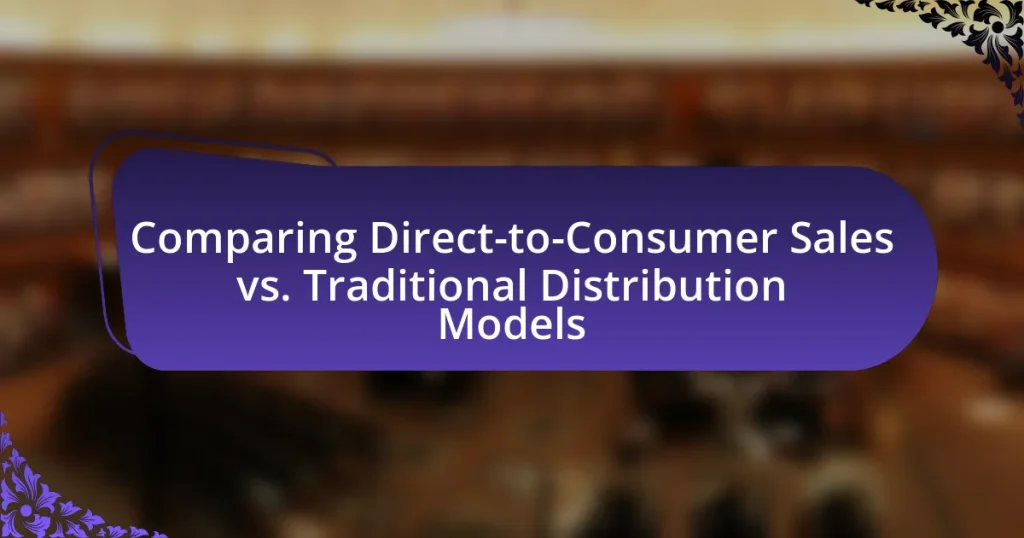The article examines the evolution of e-book distribution, tracing its origins from the late 1990s with the advent of digital formats and online bookstores, particularly highlighting the impact of Amazon’s Kindle launch in 2007. It discusses significant milestones, technological advancements, and changing consumer preferences that have shaped the e-book market, which now accounts for approximately 20% of book sales in the U.S. The article also explores current trends such as subscription services, self-publishing platforms, and the influence of artificial intelligence on personalized recommendations. Additionally, it provides insights into future predictions for e-book distribution, emphasizing the importance of adapting to emerging technologies and consumer behaviors.

What is the Evolution of E-Book Distribution?
The evolution of e-book distribution began in the late 1990s with the introduction of digital formats like PDF and the establishment of online bookstores such as Amazon, which launched its Kindle platform in 2007. This marked a significant shift from traditional print distribution to digital channels, allowing for instant access to a vast library of titles. By 2010, e-books gained substantial market share, accounting for approximately 10% of book sales in the U.S., driven by the proliferation of e-readers and tablets. The rise of self-publishing platforms, such as Smashwords and Lulu, further democratized e-book distribution, enabling authors to reach audiences directly without traditional publishing gatekeepers. As of 2023, e-book distribution continues to evolve with advancements in technology, including subscription services like Kindle Unlimited and the integration of artificial intelligence for personalized recommendations, reflecting ongoing trends in consumer behavior and digital content consumption.
How has e-book distribution changed over the years?
E-book distribution has evolved significantly over the years, transitioning from limited availability to widespread access through various platforms. Initially, e-books were primarily distributed through specialized websites and proprietary devices, such as the Sony Data Discman in the late 1990s. The introduction of the Amazon Kindle in 2007 revolutionized the market by providing a user-friendly platform that allowed consumers to purchase and download e-books directly, leading to a surge in popularity.
By 2010, the e-book market had expanded, with major publishers adopting digital formats and retailers like Apple and Google entering the space, further diversifying distribution channels. According to the Association of American Publishers, e-book sales in the U.S. grew from approximately $0.5 billion in 2008 to over $1.1 billion by 2012, illustrating the rapid adoption of digital reading.
In recent years, the rise of subscription services like Kindle Unlimited and platforms such as Scribd has shifted the distribution model towards access-based consumption rather than ownership. This trend reflects changing consumer preferences for flexibility and variety in reading materials. As of 2023, e-books account for around 20% of the overall book market, demonstrating their established presence and the ongoing evolution of distribution methods.
What technological advancements have influenced e-book distribution?
Technological advancements such as the development of the internet, e-readers, and digital rights management (DRM) have significantly influenced e-book distribution. The internet enabled instant access to a global market, allowing publishers to distribute e-books directly to consumers without the need for physical retail spaces. E-readers, like Amazon’s Kindle, provided a dedicated platform for reading e-books, enhancing user experience and driving adoption. Additionally, DRM technologies have allowed publishers to protect their intellectual property, ensuring that e-books can be securely distributed while minimizing piracy. These advancements collectively transformed the landscape of e-book distribution, making it more accessible and efficient.
How have consumer preferences shaped e-book distribution methods?
Consumer preferences have significantly influenced e-book distribution methods by driving the demand for convenience, accessibility, and diverse formats. As readers increasingly favor instant access to content, platforms like Amazon Kindle and Apple Books have emerged, allowing users to purchase and download e-books directly to their devices. This shift is supported by data indicating that 83% of e-book readers prefer digital formats for their portability and ease of use. Additionally, the rise of subscription services, such as Scribd and Kindle Unlimited, reflects consumer desires for cost-effective access to a wide range of titles, further shaping distribution strategies. These preferences have led publishers to adopt more flexible pricing models and explore innovative distribution channels, ensuring that e-books meet the evolving needs of consumers.
What are the key milestones in e-book distribution history?
The key milestones in e-book distribution history include the introduction of the first e-book in 1971, the launch of the Amazon Kindle in 2007, and the establishment of the EPUB format in 2007. The first e-book, “The Declaration of Independence,” was made available by Michael S. Hart through Project Gutenberg, marking the beginning of digital literature. The Amazon Kindle revolutionized e-book distribution by providing a dedicated e-reader and access to a vast library of titles, significantly increasing e-book sales. The EPUB format, created by the International Digital Publishing Forum, standardized e-book publishing, allowing for greater compatibility across devices and platforms, thus facilitating wider distribution.
When did e-books first become popular?
E-books first became popular in the late 1990s and early 2000s. This surge in popularity was largely driven by the introduction of dedicated e-readers, such as the Amazon Kindle in 2007, which made accessing and reading digital books more convenient. The rise of the internet and digital publishing platforms also contributed significantly to the mainstream acceptance of e-books during this period.
What role did major retailers play in the evolution of e-book distribution?
Major retailers significantly influenced the evolution of e-book distribution by establishing digital marketplaces that facilitated access to e-books for consumers. Companies like Amazon, Barnes & Noble, and Apple pioneered platforms that allowed users to purchase and download e-books directly to their devices, thereby transforming the reading experience. For instance, Amazon launched the Kindle Store in 2007, which became a dominant force in e-book sales, accounting for approximately 83% of the U.S. e-book market by 2011. This shift not only increased the availability of e-books but also encouraged traditional publishers to adapt their distribution models to include digital formats, leading to a broader acceptance of e-books in the literary market.

What current trends are shaping e-book distribution?
Current trends shaping e-book distribution include the rise of subscription services, increased use of artificial intelligence for personalized recommendations, and the growing importance of direct-to-consumer sales channels. Subscription services like Kindle Unlimited and Scribd have gained popularity, allowing readers access to a vast library for a monthly fee, which has altered traditional purchasing models. Additionally, artificial intelligence is being utilized to analyze reader preferences and enhance user experience through tailored suggestions, thereby increasing engagement and sales. Furthermore, authors and publishers are increasingly opting for direct-to-consumer sales via their own websites or platforms, bypassing traditional retailers, which allows for higher profit margins and better control over marketing strategies. These trends reflect a significant shift in how e-books are distributed and consumed in the digital marketplace.
How is digital content consumption affecting e-book distribution?
Digital content consumption is significantly reshaping e-book distribution by increasing demand for instant access and diverse formats. As consumers increasingly prefer digital platforms for reading, e-book sales have surged, with reports indicating that e-books accounted for over 20% of the total book market in 2022. This shift has prompted publishers to adopt more flexible distribution models, such as subscription services and direct-to-consumer sales, to meet the evolving preferences of readers. Additionally, the rise of mobile devices and e-readers has facilitated greater accessibility, allowing consumers to purchase and read e-books anytime and anywhere, further driving the growth of the e-book market.
What demographic shifts are influencing e-book readership?
Younger generations, particularly Millennials and Gen Z, are significantly influencing e-book readership due to their comfort with digital technology and preference for mobile devices. Research indicates that these demographics are more likely to engage with e-books compared to older generations, with a 2021 survey showing that 45% of respondents aged 18-29 read e-books, compared to only 20% of those aged 50 and above. Additionally, the increasing availability of e-books through libraries and subscription services has made them more accessible, further driving readership among younger audiences. This shift is also reflected in the growing trend of self-publishing, which appeals to younger authors seeking to reach digital-native readers.
How are subscription models changing the e-book distribution landscape?
Subscription models are transforming the e-book distribution landscape by providing readers with unlimited access to a vast library of titles for a fixed monthly fee. This model encourages higher reading engagement, as users can explore diverse genres without the financial burden of purchasing individual books. According to a report by the Association of American Publishers, subscription services have seen significant growth, with platforms like Kindle Unlimited and Scribd reporting millions of subscribers, which indicates a shift in consumer behavior towards more flexible reading options. Additionally, publishers benefit from subscription models through increased exposure and potential sales of individual titles, as readers often discover new authors and books within these platforms.
What impact do self-publishing platforms have on e-book distribution?
Self-publishing platforms significantly democratize e-book distribution by enabling authors to publish their works without traditional gatekeepers. These platforms, such as Amazon Kindle Direct Publishing and Smashwords, allow authors to reach global audiences directly, bypassing conventional publishing houses. According to a 2021 report by the Independent Book Publishers Association, self-published titles accounted for over 30% of e-book sales in the U.S., illustrating the growing influence of these platforms on the market. This shift not only increases the volume of available titles but also diversifies the types of content accessible to readers, fostering a more inclusive literary landscape.
How do self-publishing platforms empower authors?
Self-publishing platforms empower authors by providing them with direct access to the market, allowing them to publish their work without traditional gatekeepers. These platforms enable authors to retain full control over their content, pricing, and royalties, often resulting in higher earnings compared to traditional publishing models. For instance, authors can earn up to 70% royalties on e-books sold through platforms like Amazon Kindle Direct Publishing, compared to the typical 10-15% offered by traditional publishers. Additionally, self-publishing platforms offer tools for marketing and distribution, facilitating a broader reach to potential readers. This democratization of publishing has led to a significant increase in the number of independent authors, with reports indicating that self-published titles accounted for over 30% of e-book sales in recent years.
What challenges do self-published authors face in distribution?
Self-published authors face significant challenges in distribution, primarily due to limited access to traditional retail channels. Unlike traditionally published authors, self-published authors often struggle to get their books into brick-and-mortar bookstores, which can significantly reduce their visibility and sales potential. Additionally, self-published authors must navigate various online platforms, each with its own requirements and algorithms, making it difficult to effectively market their work. According to a 2021 survey by the Alliance of Independent Authors, 60% of self-published authors reported that distribution was one of their top challenges, highlighting the complexities involved in reaching a wider audience.

What predictions can be made about the future of e-book distribution?
Predictions about the future of e-book distribution indicate a significant shift towards subscription-based models and increased integration of artificial intelligence. Subscription services, such as Kindle Unlimited and Scribd, are expected to grow, providing readers with access to vast libraries for a monthly fee, which aligns with consumer preferences for cost-effective reading options. Additionally, the use of AI in e-book distribution will enhance personalized recommendations, improving user experience and engagement. According to a report by Research and Markets, the global e-book market is projected to reach $20.5 billion by 2025, driven by these trends and the increasing adoption of digital reading devices.
How might technology further transform e-book distribution?
Technology might further transform e-book distribution through advancements in artificial intelligence and blockchain. Artificial intelligence can enhance personalized recommendations and streamline the publishing process, allowing for more targeted marketing and improved reader engagement. For instance, AI algorithms can analyze reader preferences and suggest titles that align with individual tastes, increasing sales and reader satisfaction. Blockchain technology can revolutionize copyright management and royalty distribution by providing transparent, secure transactions that ensure authors receive fair compensation. According to a report by the World Intellectual Property Organization, blockchain can reduce piracy and enhance trust in digital content distribution. These technological innovations are poised to reshape the landscape of e-book distribution significantly.
What emerging technologies could influence e-book formats and accessibility?
Emerging technologies such as artificial intelligence, augmented reality, and blockchain are poised to significantly influence e-book formats and accessibility. Artificial intelligence can enhance personalized reading experiences through adaptive content that adjusts to individual preferences, while augmented reality can create immersive reading environments that integrate multimedia elements. Blockchain technology offers secure distribution and ownership verification, potentially transforming how e-books are purchased and shared. These technologies not only improve user engagement but also broaden access for individuals with disabilities, ensuring that e-books are more inclusive and versatile.
How will artificial intelligence impact e-book recommendations and marketing?
Artificial intelligence will significantly enhance e-book recommendations and marketing by utilizing advanced algorithms to analyze user behavior and preferences. These algorithms can process vast amounts of data, enabling personalized recommendations that align closely with individual reading habits, thereby increasing user engagement and sales. For instance, a study by McKinsey & Company found that personalized recommendations can lead to a 10-30% increase in sales for e-commerce platforms. Additionally, AI-driven marketing strategies can optimize targeting and segmentation, allowing publishers to reach specific demographics more effectively, which has been shown to improve conversion rates.
What changes in consumer behavior are expected in the future?
Future changes in consumer behavior are expected to include a significant shift towards digital consumption, particularly in the realm of e-books. As technology advances, consumers are increasingly favoring convenience and accessibility, leading to a rise in e-book purchases over traditional print formats. According to a report by the Association of American Publishers, e-book sales have consistently increased, with a 16.5% growth in 2020 alone, indicating a strong trend towards digital reading. Additionally, younger demographics, particularly millennials and Gen Z, are more inclined to use e-readers and mobile devices for reading, further driving this transition. This shift is also influenced by the growing availability of subscription services, which offer consumers access to vast libraries of e-books for a flat fee, enhancing the appeal of digital formats.
How might the rise of audiobooks affect e-book distribution?
The rise of audiobooks may lead to a decline in e-book distribution as consumer preferences shift towards audio formats. This trend is supported by the increasing popularity of platforms like Audible, which reported over 500,000 titles available in 2021, indicating a growing market for audiobooks. As more readers opt for the convenience of listening rather than reading text, e-book sales could experience stagnation or reduction, particularly among younger demographics who favor mobile and audio content. Additionally, publishers may allocate resources towards audiobook production, potentially diverting attention from e-book development and marketing.
What role will social media play in promoting e-books?
Social media will play a crucial role in promoting e-books by providing platforms for targeted marketing, community engagement, and direct author-reader interaction. These platforms enable authors and publishers to reach specific demographics through targeted ads, increasing visibility and sales. For instance, a study by the Pew Research Center found that 72% of adults use social media, making it an effective channel for reaching potential readers. Additionally, social media facilitates the creation of communities around genres or authors, fostering discussions and recommendations that can drive e-book sales. This engagement not only enhances visibility but also builds a loyal reader base, further solidifying the role of social media in e-book promotion.
What best practices should authors and publishers adopt for future e-book distribution?
Authors and publishers should adopt a multi-platform distribution strategy for future e-book distribution. This approach maximizes reach by making e-books available on various platforms, such as Amazon Kindle, Apple Books, and Google Play Books, which collectively account for a significant portion of the e-book market. According to a 2022 report by Statista, Amazon held approximately 83% of the U.S. e-book market share, highlighting the importance of being present on dominant platforms while also exploring niche markets to cater to diverse reader preferences. Additionally, implementing effective metadata practices, such as using relevant keywords and categories, enhances discoverability, as studies show that optimized metadata can increase sales by up to 30%. Furthermore, engaging in direct marketing through email newsletters and social media can foster a loyal reader base, as research indicates that personalized marketing strategies yield higher conversion rates. By following these best practices, authors and publishers can effectively navigate the evolving landscape of e-book distribution.
How can authors effectively market their e-books in a competitive landscape?
Authors can effectively market their e-books in a competitive landscape by leveraging targeted digital marketing strategies, including social media promotion, email marketing, and search engine optimization (SEO). Utilizing platforms like Facebook, Instagram, and Twitter allows authors to engage directly with potential readers, while email marketing can help build a loyal audience by providing updates and exclusive content. According to a 2021 survey by the Book Industry Study Group, 45% of readers discover new books through social media, highlighting its importance in reaching a wider audience. Additionally, optimizing e-book listings with relevant keywords can improve visibility on platforms like Amazon, where 70% of e-books are sold, making SEO a crucial component of an effective marketing strategy.
What strategies can publishers implement to adapt to changing trends?
Publishers can implement several strategies to adapt to changing trends, including embracing digital transformation, utilizing data analytics, and diversifying distribution channels. Embracing digital transformation allows publishers to create interactive and multimedia-rich content that meets the evolving preferences of readers. Utilizing data analytics enables publishers to understand consumer behavior and preferences, allowing for targeted marketing and personalized content offerings. Diversifying distribution channels, such as partnering with subscription services and leveraging social media platforms, helps publishers reach wider audiences and adapt to shifts in how readers consume content. These strategies are supported by the increasing demand for digital content, as evidenced by the growth of e-book sales, which reached approximately $1.1 billion in the U.S. in 2020, highlighting the need for publishers to evolve in response to market trends.



